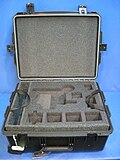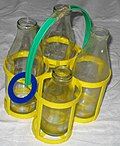Reusable packaging
 From Wikipedia - Reading time: 10 min
From Wikipedia - Reading time: 10 min
Reusable packaging is manufactured of durable materials and is specifically designed for multiple trips and extended life. A reusable package or container is "designed for reuse without impairment of its protective function."[1] The term returnable is sometimes used interchangeably but it can also include returning packages or components for other than reuse: recycling, disposal, incineration, etc. Typically, the materials used to make returnable packaging include steel, wood, polypropylene sheets or other plastic materials.[2]
Reusability of packaging is an important consideration of the environmental credo of "reduce, reuse, and recycle". It is also important to the movement toward more sustainable packaging.[3] Returnable packaging is encouraged by regulators.[4][5]
Shipping containers
[edit]For many years, several types of shipping containers have been returnable and reusable. These have made most sense when a reverse logistics system is available or can be readily developed.[6] A return, reconditioning, and reuse system can save money on the cost per shipment and can reduce the environmental footprint of the packaging.[7][8]
Manufacturing, particularly the automotive industry, has used heavy-duty returnable racks for shipping hoods, fenders, engines, dashboards, etc. from suppliers to final assembly plants. The racks are then returned for the next shipment cycle.
Bulk foods, chemicals, and pharmaceuticals are often shipped in reusable and returnable containers. These need to be carefully inspected, cleaned and sanitized as part of the reuse cycle. An effective quality management system is necessary.
Wooden pallets are often made to be expendable, for a single shipment. Others are heavy duty and intended for multiple shipments. Some are in "pallet pools" which are used, inspected, and refurbished for extended usage.
Often reusable industrial shipping containers have bar code labels or radio-frequency identification (RFID) chips to help identify and route the containers.
-
A typical keg (half-barrel) with a single opening in the center of the top end
-
Industrial compressed gas cylinders
-
Steel drums can be reconditioned and reused
-
Returnable/reusable plastic tote box, Euro container
-
Reusable boxes for pallet shipping
-
Heavy-duty reusable wooden pallet
-
Plastic molded transit case with pre-cut foam interior
-
Container for bulk vegetable oil
-
Reusable field bins for fruit
-
Stackable plastic containers
-
Carrots on display in returnable plastic bins
Use in the automotive industry
[edit]Automotive original equipment manufacturers (OEMs) use and encourage the use of returnable packaging to move components from their vendors to their factories. The components are placed in returnable packaging and are at times and arranged in a way that facilitates movement straight to assemble lines. Such packaging replaces traditional corrugated cartons, thereby helping companies cut costs by avoiding wastage and effort required in disposing the cartons. It also helps in reducing the environmental footprint of the automotive industry.
Other advantages of using returnable packaging include avoiding damages to parts in while in transit. Parts are at times placed in specially designed receptacles for easy picking on the assembly line contributing to fewer mistakes and simpler inventory management.
A few examples of returnable packaging in automotive industry:
 |
 |
 |
 |
Consumer packaging and containers
[edit]Several types of consumer containers have been in reuse systems. Reusable bottles for milk, soda, and beer have been part of closed-loop use-return-clean-refill-reuse cycles. Food storage containers are typically reusable. Thick plastic water bottles are promoted as an environmental improvement over thin single-use water bottles. Some plastic cups can be re-used, though most are disposable.
Home canning often uses glass mason jars which are often reused several times.
Many non-food types of containers, including reusable shopping bags, and luggage, are designed to be reused by consumers.
With any food packaging, proper cleaning and disinfecting between each use is critical to health.
In September 2019, the UK Environment, Food and Rural Affairs Committee released a report claiming that the official intervention should encourage more shops to offer refillable options instead of traditional single-use packing.[9]
-
Home storage containers
-
Delivering milk in India in reusable stainless steel containers
-
Reusable milk bottles and carrier
-
Reusable shopping bag
-
Mason jars for canning
-
Glass bottles of mineral water in crates
-
Christmas tree ornaments in storage boxes
-
Refillable liquid soap dispenser
-
Flip-top or bail closure on storage jar
-
Gass grill with reusable liquefied petroleum gas cylinder
Reuse for other purposes
[edit]Used packages are often reused for purposes other than their primary use. For example, a single-use plastic shopping bag might be reused as a bin bag, a household storage bag or a dog faeces bag. Steel drums can be reused as traffic barricades, dock flotation, and as musical instruments
-
Furniture made from milk crates
-
Pails being reused to carry other items
-
Architecture with intermodal shipping containers
-
Woman sewing chair covers, bedspread, and other things made from cotton flour sacks in Alabama
Justification
[edit]Reusable packaging often costs more initially and uses more and different materials than single-use packaging. It often requires adding complexity to the distribution system.[10] Not all packaging justifies being returnable and reusable.
A thorough cost analysis is required. This involves all of the material, labor, transport, inspection, refurbishing, cleaning, and management costs. Often these costs may be incurred by different companies with different cost structures.[11][12]
The environmental costs and benefits can also be complex. The material, energy, pollution, etc. needs to be accounted for throughout the entire system. A life cycle assessment offers a good methodology for this task.[13][14][15][16]
See also
[edit]- Pallet crafts
- Economics of plastics processing § Reusable plastic containers
- Resealable packaging
- Reverse logistics
- Shaker-style pantry box
- Systainer
- Closed-loop box reuse
- 32 mm cabinetmaking system, a standard for shelving
References
[edit]- ^ ASTM D996
- ^ Soroka, W. Illustrated Glossary of Packaging Terminology (Second ed.). Institute of Packaging Professionals. p. 185.
- ^ Coelho, Patricia Megale; Corona, Blanca; ten Klooster, Roland; Worrell, Ernst (2020). "Sustainability of reusable packaging–Current situation and trends". Resources, Conservation & Recycling: X. 6: 100037. doi:10.1016/j.rcrx.2020.100037.
- ^ Use Reusables: Fundamentals of Reusable Transport Packaging (PDF), US Environmental Protection Agency, 2012, archived from the original (PDF) on January 14, 2015, retrieved 28 June 2014
- ^ Golding, A (2004), Reuse of Primary Packaging (PDF), Contract B4-3040/98/000180/MAR/E3, European Commission, retrieved 30 June 2014
- ^ Twede, D (2009), "Logistical/Distribution Packaging", in Yam, K L (ed.), Encyclopedia of Packaging Technology, Wiley, ISBN 978-0-470-08704-6
- ^ Ernst & Young Accountants (2014), Life Cycle Assessment of Newly Manufactured and Reconditioned Industrial Packaging (PDF), Reusable Industrial Packaging Association
- ^ Zimmerman, T (2020). "Single-use vs. reusable packaging in e-commerce: comparing carbon footprints and identifying break-even points" (PDF). GAIA. 29 (3): 176–173. doi:10.14512/gaia.29.3.8. S2CID 235861717. Retrieved 7 May 2023.
- ^ "Plastic food and drink packaging". Publications.parliament.uk. 12 September 2019.
- ^ Twede, S (2004). "Supply Chain Issues in Reusable Packaging". Journal of Marketing Channels. 12 (1): 7–26. doi:10.1300/J049v12n01_02. S2CID 153350817.
- ^ Tomey, R D (1995). "Returnable Packaging Components in Physical Distribution Systems". In Fiedler, R M (ed.). Distribution Packaging Technology. Institute of Packaging Professionals.
- ^ Harder, MS (1996). "How to Develop a Returnable Pack for Multiple Plant Use". In Fiedler, R M (ed.). The Best of TransPack. Institute of Packaging Professionals.
- ^ Mata, T M (2001). "Life cycle assessment of different reuse percentages for glass beer bottles". International Journal of Life Cycle Assessment. 6 (5): 58–63. doi:10.1007/BF02978793. S2CID 111259179.
- ^ Spitzly, David (1997), Life Cycle Design of Milk and Juice Packaging (PDF), U.S. Environmental Protection Agency, retrieved 29 June 2014
- ^ Singh, J; Krasowski, Singh (January 2011), "Life cycle inventory of HDPE bottle-based liquid milk packaging systems", Packaging Technology and Science, 24: 49–60, CiteSeerX 10.1.1.1029.2590, doi:10.1002/pts.909, S2CID 6850034
- ^ Van Doorsselaer, K; Fox (2000), "Estimation of the energy needs in life cycle analysis of one-way and returnable glass packaging", Packaging Technology and Science, 12 (5): 235–239, doi:10.1002/(SICI)1099-1522(199909/10)12:5<235::AID-PTS474>3.0.CO;2-W
Books, general references
[edit]- Design Criteria for Specialized Shipping Containers, US DoD, Mil-Std 648D, 1999, [1]
- McKinlay, A. H., "Transport Packaging", Institute of Packaging Professionals, 2004
- Yam, K.L., "Encyclopedia of Packaging Technology", John Wiley & Sons, 2009, ISBN 978-0-470-08704-6
Industry Associations
 KSF
KSF























